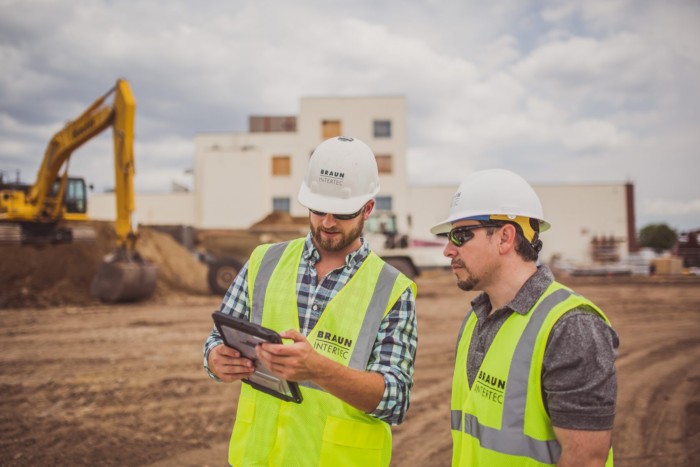Little Known Facts About Geotheta.
Little Known Facts About Geotheta.
Blog Article
The 45-Second Trick For Geotheta
Table of ContentsA Biased View of GeothetaGetting The Geotheta To WorkThe 6-Minute Rule for GeothetaExamine This Report about GeothetaGeotheta Things To Know Before You Buy

They carry out website investigations, gather examples, do lab examinations, and analyze data to assess the suitability of the ground for building projects - Consulting Engineer. Based on their searchings for, geotechnical engineers supply referrals for structure layout, incline security, retaining frameworks, and reduction of geotechnical dangers. They work together with various other experts, such as designers, architectural engineers, and building teams, to make sure that geotechnical considerations are integrated right into the general task style and application
By analyzing the actions and homes of dirt and rock, they can identify possible geotechnical risks such as landslides, soil settlement, or incline instability. Their knowledge aids stop failings or accidents that can threaten lives and home. Here are some thorough duties and duties of a geotechnical designer: Website Investigation: Geotechnical designers conduct website examinations to gather data on subsurface problems.
They analyze the information to comprehend the properties and actions of the soil and rock, including their stamina, leaks in the structure, compaction features, and groundwater conditions. Geotechnical Analysis and Layout: Geotechnical engineers analyze the information collected throughout website investigations to assess the security and suitability of the website for construction projects. They execute geotechnical estimations and modeling to evaluate variables such as birthing ability, negotiation, slope stability, lateral earth stress, and groundwater flow.
The Only Guide for Geotheta
Structure Design: Geotechnical designers play a vital role in designing foundations that can securely support the designated structure. They examine the soil conditions and tons needs to identify the suitable structure type, such as superficial structures (e.g., grounds), deep foundations (e.g (https://slides.com/geotheta)., heaps), or specialized strategies like soil improvement. They consider variables such as settlement restrictions, bearing ability, and soil-structure interaction to establish ideal foundation layouts
They review construction strategies, screen website activities, and perform area evaluations to validate that the layout recommendations are adhered to. If unforeseen geotechnical problems occur, they examine the situation and give suggestions for removal or adjustments to the style. Risk Analysis and Reduction: Geotechnical engineers analyze geotechnical risks and risks connected with the project site, such as landslides, liquefaction, or dirt disintegration.

Cooperation and Communication: Geotechnical designers work very closely with other experts associated with a task, such as engineers, structural engineers, and building teams. Reliable interaction and collaboration are important to integrate geotechnical considerations right into the total task style and construction process. Geotechnical engineers give technological experience, answer questions, and ensure that geotechnical demands are fulfilled.
Unknown Facts About Geotheta
Below are some kinds of geotechnical engineers: Foundation Engineer: Structure designers focus on creating and assessing structures for structures. They evaluate the soil conditions, load requirements, and site attributes to figure out one of the most appropriate structure type and style, such as shallow foundations, deep foundations, or specialized strategies like stack structures.
They examine the elements affecting incline stability, such as soil buildings, groundwater problems, and incline geometry, and create approaches to protect against slope failures and mitigate risks. Quake Designer: Quake designers focus on evaluating and making frameworks to stand up to seismic forces. They examine the seismic threat of a site, evaluate dirt liquefaction possibility, and establish seismic layout standards to make sure the security and resilience of frameworks during quakes.
They perform area screening, collect examples, and examine the gathered information to define the soil homes, geologic formations, and groundwater problems at a website. Geotechnical Instrumentation Engineer: Geotechnical instrumentation designers concentrate on surveillance and determining the behavior of dirt, rock, and structures. They mount and maintain instrumentation systems that keep an eye on elements such as soil negotiation, groundwater degrees, slope motions, and structural variations to assess performance and give early cautions of possible problems.
What Does Geotheta Do?
They carry out examinations such as triaxial examinations, loan consolidation tests, direct shear examinations, and leaks in the structure tests to gather data for geotechnical analysis and style. Geosynthetics Designer: Geosynthetics designers specialize in the style and application of geosynthetic products, such as geotextiles, geogrids, and geomembranes. They make use of these products to enhance dirt security, strengthen inclines, give water drainage solutions, and control erosion.
They often tend to be investigative individuals, which implies they're intellectual, introspective, and curious. They wonder, methodical, reasonable, logical, and logical. A few of them are likewise social, implying they're kind, charitable, participating, patient, caring, valuable, understanding, tactful, and friendly. Does this sound like you? Take our totally free job examination to figure out if geotechnical engineer is original site one of your top career matches.
In the office atmosphere, geotechnical designers use specialized software application tools to do computations, create layouts, and examine data. They prepare records, evaluation job specifications, connect with clients and team participants, and coordinate project tasks. The workplace setting offers a conducive atmosphere for research, analysis, and partnership with other professionals entailed in the job.
The Geotheta Ideas
They often visit job websites to conduct site examinations, assess geotechnical problems, and gather information for evaluation. These check outs entail taking a trip to different places, sometimes in remote or difficult surfaces. Geotechnical designers may do dirt tasting, conduct tests, and monitor building activities to make sure that the geotechnical elements of the project are being applied correctly.
Geotechnical designers also work in specialized geotechnical labs. Geotechnical research laboratory designers work thoroughly in these environments, taking care of screening devices, running instruments, and recording information.
Report this page